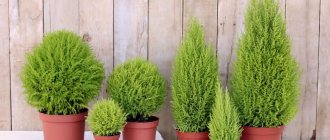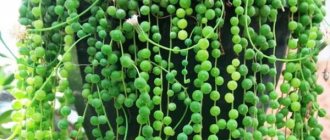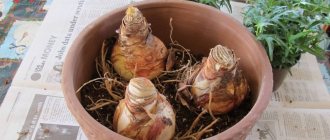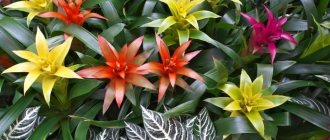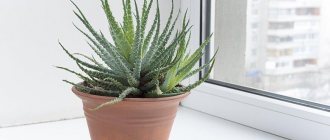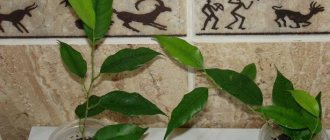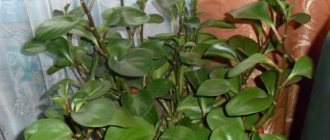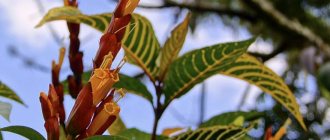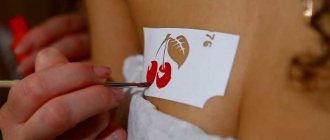Information about Haworthia
It happens that this plant produces a flower stalk. But often it is simply cut off due to the lack of decorative value. The following main types of haworthia can be distinguished:
- Haworthia pearly - green leaves randomly covered with white pimples;
- Haworthia striped - the leaves are long and sharp, white pimples form rows;
- Haworthia checkerboard - wide and short leaves with jagged edges;
- Haworthia Reinwardtia is the only species that has a stem up to 20 cm in height, covered with triangular leaves.
The plant is often called colored aloe. But this is a cactus. In case of heat, the plant stores moisture in its fleshy leaves.
The succulent received its name in honor of the botanist Adrian Haworth, who was the first to classify it among plants.
Haworthia care
A very light-loving plant, loves southern windows. Only in the midday heat can you put it in partial shade. In the summer, you can take it out into the open air, into the attic or balcony.
Haworthia does not need abundant watering. Watering should be done as the soil dries out. Despite the fact that this plant does not require air humidity, when placing it near a heating device, it should be occasionally sprayed with warm water.
It is recommended to use soil: 1 part clay-turf soil, 1 part leaf soil, 1 part sand. If you take ready-made mixtures, then a substrate for succulents is suitable. Be sure to use drainage.
Attention should be paid to feeding the plant; the roots are very sensitive to the composition of fertilizers. It is necessary to fertilize in the summer, when the temperature remains stably above 20°C.
It is not recommended to make a mixture for feeding yourself; it is better to buy ready-made ones. Any substrate for cacti is suitable, only very diluted: proportions 1/10. The frequency of fertilizing is once every 3 weeks. If the succulent is not cared for correctly, this can be immediately noticed by the appearance of the leaves. They will start to turn red or yellow
It is necessary to fertilize in the summer, when the temperature remains stably above 20°C. It is not recommended to make a mixture for feeding yourself; it is better to buy ready-made ones. Any substrate for cacti is suitable, only very diluted: proportions 1/10. The frequency of fertilizing is once every 3 weeks. If the succulent is not cared for correctly, this can be immediately noticed by the appearance of the leaves. They will begin to turn red or yellow.
Transfer
Does not require frequent transplantation. An adult plant is sufficient once every 2 years, in the spring. The capacity should be increased as the pot fills with the root system. Most of the roots are on the surface, so it is better to use low, wide pots.
The plant develops better if the root system is slightly constrained. You shouldn’t immediately take a pot 2-3 sizes larger; it’s better to replant the rapidly developing succulent later.
It is not advisable to bury the root system deeply. If you add brick chips to the soil - in addition to drainage - then during the winter rest period the plant can be watered no more than 2 times a month. The necessary moisture from the soil will not evaporate.
Reproduction
Haworthia is propagated by daughter rosettes and dried leaf cuttings:
The rosette must be separated from the mother plant very carefully so as not to damage its already sufficiently developed root system. During transplantation into a separate container, the prepared substrate must be sufficiently moistened
After transplanting the rosette, the top layer is sprinkled with a thin layer of sand; Unlike the usual method of propagation using leaves, Haworthia shoots are not placed in water. On the contrary, a sheet cut with a sharp knife is left indoors at normal room temperature for 2 days to dry it. It is then placed in damp sand and left there for a month. During this time, the leaf takes root and is transplanted into a regular substrate.
You can propagate succulents using seeds. But only professionals use this method. It is labor intensive and requires special skills.
Pests and diseases
If pests are found, they need to be dealt with. Otherwise the plant will die. To do this, make a solution from a slurry of soap and grated garlic, which are mixed in equal proportions and filled with water until the consistency of liquid sour cream. Leaves are regularly wiped with this mixture.
For preventive purposes, the plant can be treated once a month. Growing Haworthia is easy. If the plant begins to “sick,” then this is a consequence of violation of the rules of care. When you do everything correctly, the succulent will delight you with its appearance for many years.
The necessary conditions
If your goal is to make your haworthia bloom, you should create all the conditions for this. And don't be upset if you didn't get to see it this year. Perhaps next time the plant will delight you with abundant flowering.
Firstly - lighting. The succulent can grow without light, however, it also performs well in the sun. Since Haworthia comes from a hot climate zone, it copes with sunlight, so it grows well in shade or partial shade. Due to the lack of light and illumination, the plant may die. In the modern world, haworthia is an ornamental plant that has gained great popularity. It is of particular value due to the fact that it does not require special care.
Secondly, you should definitely pay attention to the air temperature in the room where the flower is located. Differences between day and night readings can affect growth. REFERENCE: In spring the temperature should be from 20 to 30 degrees. In cold times it is 16-18 degrees. Air humidity should be at an average level.
If we talk about fertilizing the plant, then this is not necessary. An exception may be a situation in which the haworthia begins to wither and fade
In this case, you can properly stimulate its root system. You can fertilize the plant only once a year, and for these purposes it is better to use fertilizers for succulents and cacti. It is important to use a solution that is not too concentrated, as it will only harm the plant. Light feeding will allow the succulent to receive many nutritional properties, which will have a beneficial effect on development and flowering.
The soil must contain foliage and turf
Properly selected will affect both the growth and flowering of Haworthia. You can buy ready-made succulent soil or make your own.
Features of keeping at home
Dollar tree photo, how it blooms, description and care at home.
Haworthia is unpretentious. Keeping and propagating it at home is not particularly difficult. Even if you are a beginner gardener and you simply don’t have time to fully care for plants, but have a desire to have them, Haworthia is exactly what you need. By following simple rules, you will cope with the task.
Even beginners can keep haworthia at home
Popular varieties - table
| Name | Description of the plant |
| Haworthia pearl | A highly decorative appearance with lanceolate, thick and fleshy leaves directed upwards, up to 7 cm long. The main color is dark green, against its background white growths similar to pearls stand out. The inflorescence consists of small greenish flowers located on a peduncle 30 cm high. |
| Haworthia striped | The most popular species has lanceolate leaves growing from the root. Not very meaty, but dense. They grow up to 10 cm in length. The color is dark green. The upper side of the leaf is smooth, and on the lower side there are growths that form a striped pattern. The peduncle is long and brown. Decorated with small white flowers. |
| Haworthia checkerboard or mosaic | Does not have a stem. The leaves are thick, triangular in shape, and grow in a spiral. The lower side is convex, the upper is flat. They reach a length of 3.5 cm. The apex is pointed, and small denticles are located along the edge of the leaf. The color of the leaf plate is green, the surface is decorated with a white pattern reminiscent of the cells of a chessboard. The flowers are white-green and collected in a small panicle. |
| Haworthia Big Band | The length of the leaves, narrow and fleshy, reaches 5–10 cm. The shape is linearly pointed. The color is dark green. The upper side of the leaf is plain, the lower side is decorated with bright white specks, forming a striped pattern. White inconspicuous flowers are located on a brown peduncle. The look is very decorative. |
| Haworthia lemonfolia | The leaves, shaped like a wide triangle, are hard and dense. They form a rosette 10 cm in diameter. Painted dark green or yellow. The lower and upper sides of the leaf blade are covered with wavy growths that are not found in other types of Haworthia. Blooms with small white flowers. |
| Haworthia Reinwardt | Small thick leaves with teeth are very numerous and tightly fit the stem. They grow in a vertical direction. The shape is lanceolate, the leaf length is 3.5 cm. The plant itself reaches a height of 15 cm. The underside of the leaf is strewn with multiple wart-like growths of bright white color. There are few of them on the upper side. The inflorescence consists of yellow-green flowers collected in a raceme. The peduncle is long. |
| Haworthia elongated pointed | The leaves are dense and wide. They form a star-like rosette. There are transparent “windows” on the upper side of the sheet. |
| Haworthia Maugana | The leaves growing straight upward look like cylinders. All are the same height. The inflorescence resembles a white-green brush. |
| Haworthia arachnoid | The processes located along the perimeter of the leaves are located close to each other and look like a cobweb. Sometimes this dense plexus resembles a ball covering the leaves. |
Such different haworthias in the photo
Features of seasonal care - table
| Season | Lighting and location | Air and soil humidity | Temperature |
| Spring | Haworthia loves bright but diffused light. It will feel good on an east or west window. The southern one is also suitable, but with shading during the midday hours. In summer, it is good to take the plant out onto the balcony, placing it in light shade. Remember that haworthia must be protected from rain. The room in which the plant is kept must be well ventilated. After winter, Haworthia begins to be accustomed to sunlight gradually. | Air humidity does not matter for Haworthia. But the soil moisture is high. On particularly hot days, when the plant’s root system stops working, wet soil can lead to the death of the plant. In summer, you can wipe leaves with a smooth surface with a damp cloth to remove accumulated dust. | The optimal temperature for this period is +20...+25 °C during the day. At night - not lower than +15 °C. Haworthia can tolerate short-term heat up to +40 °C. But if the period of elevated temperatures drags on, the plant may fall into stagnation, that is, physiological hibernation. |
| Summer | |||
| Autumn | In winter, the plant is not sprayed under any circumstances. At low temperatures, the soil should be dry. | In order for the plant to go through the dormant period, the winter temperature must be lowered to +5...+10 °C. At temperatures above +10 °C, haworthia will continue to grow, which without sufficient light will lead to a loss of decorativeness. | |
| Winter |
In summer, haworthia can be taken outside, shaded from the sun
Types of South African dwarf
Multiple types of haworthia are divided into “window”, hard-leaved and herbaceous. The first are very similar to lithops, and therefore also received the nickname “living stones”. The latter, as a rule, have peculiar growths on the leaf plate. They look like round or long warts, the color of which often differs from the main color of the leaf and stands out sharply against its background.
- Striped. This type of haworthia reaches a height of no more than 5 cm. On the back side of the leaf plate, which is clearly visible to the eye due to the vertical arrangement of the leaves, there are white growths. From a distance they resemble transverse stripes, and it seems as if someone painted the plant with a brush.
- Pulled away. Similar to the previous one. However, it is not at all as decorative as its predecessor. It has no transverse white stripes. Instead, the flower has small warts that match the leaf plate. The height of the haworthia extended does not exceed 7 cm.
- Twisty. In many sources this flower is called “Aloe tortuous”. The succulent really looks like aloe, only in miniature. The leaves form something like a spiral. The maximum plant height is 15 cm.
- Sticky. A small ornamental plant with three rows of leaves. Each sheet is similar in shape to a boat - elongated, with edges curved inward. The maximum height of this indoor flower is 20 cm.
- Chess. It has boat-shaped leaves with prickly teeth along the edges and an unusual color. The inner leaf plate seems to be drawn with a pencil. A checkered succulent is often called a mosaic succulent.
- Limofolia. The spreading narrow leaves of this succulent are colored with a gradient - from dark green to lemon. The leaf blade has warty growths and transverse ribs clearly visible on the surface of the leaf.
- Reinwardt. A flower that differs from most of its fellows in its vertical growth. On average it reaches a height of 10 cm. The color of the leaves is rich dark green. Contrasting white warty growths-dots are very clearly visible on it.
- Pearl. The oval leaves of this species are scattered, like porcupine quills, in different directions. The lush green color of the leaf blade and white warts in the form of small balls make it especially decorative.
- Grater-shaped. This haworthia is very similar to the pearl one. Only its leaves are longer, and its warts are even smaller.
- Herbaceous. Haworthia creeping along the floor has a rosette diameter of no more than 5 cm. Each leaf has almost invisible cilia along the edge.
- Arachnoid. Haworthia, similar to the previous species and also having eyelashes. Only they are longer than those of the grassy one. And intertwining, they form a kind of web.
- Mesh. The color of the leaves of this species is yellow-green. And the growths present on the leaves form an openwork mesh on the inner surface of the leaf plate.
- Scaphoid. The plant has glossy, juicy green leaves. In a pot, as a rule, there is not one, but several rosettes of Haworthia. The diameter of each of them is on average 8 cm.
- Dulled. Reminds me of a pile of stones. But in fact these are not stones, but dull leaves. The color of the leaf blade can vary from dark green to brick.
- Maugana. The leaves of the species are cylindrical in shape. They are collected in a single bundle, directed towards the sky and have exactly the same length. It seems as if someone once cut off the leaf blades with a knife, leveling the height of the plant.
- Chopped off. The leaves resemble a menorah - a seven-barrel candlestick. The diameter of the species does not exceed 8 cm. And the thick dark cylindrical leaf plates are collected in two rows and are located in a single plane.
Varieties of Haworthia
Carissa flowers Care at home Reproduction of indoor plum Photos of species
There are three groups of plants belonging to Haworthia.
Rigid-leaved plants
Typically, the leaves of such haworthias are green, very hard, triangular or conical in shape. This group includes the following types:
Haworthia Reinwardt
- Striped Haworthia (lat. Haworthia fasciata) - is a rosette with rather narrow and long leaves of dark green color. The leaves of this species are smooth on top, and on the bottom they are strewn with white convex dots, which merge in places to form clear transverse stripes;
- Haworthia attenuata - outwardly similar to the previous species, but its leaves are narrower and longer, and the dots on them are not so bright white, but rather greenish-white and rather small.
- Haworthia tortuosa (lat. Haworthia tortuosa) - has dark green leaves, pointed-keeled, convex at the bottom, with very small growths over the entire surface of the leaf;
- Sticky Haworthia (lat. Haworthia viscosa) - leaves with a rough surface, bright green, arranged in three rows; the tips of the leaves are pointed red, burgundy or even brown;
- Haworthia reinwardtii (lat. Haworthia reinwardtii) - differs from other species: the stem can grow up to 20 cm in height, has a fleshy, spotted rosette of leaves arranged in a spiral, the ends of which are pointed;
- Pearl Haworthia (lat. Haworthia margaritifera) - has olive-green sharp leaves collected in a rosette with a diameter of up to 20 cm; the leaves are strewn with a large number of white tubercles, reminiscent of pearls.
Herbaceous
In herbaceous haworthias, the leaves form a stemless rosette. The leaves are ciliated, very small, triangular in shape. The main types of this group:
- Haworthia arachnoidea (lat. Haworthia arachnoidea) - is a dense rosette of dark green triangular leaves, on which long “cilia” are located in large numbers, forming something like a web;
- Haworthia reticulata (lat. Haworthia reticulata) - has a dense rosette of leaves with a mesh pattern over the entire surface, along the edges of which there are small notches;
- Haworthia herbacea (lat. Haworthia herbacea) - keel-shaped leaves of a characteristic “grassy” color, the edges are abundantly strewn with “cilia”.
Window type group
Window-type Haworthias are close to lithops. It is in this group that translucent areas on the stems and leaves predominate, due to which the plant saves water in its natural environment. This group includes:
- Haworthia boat-shaped (lat. Haworthia cymbiformis) is a small rosette consisting of light green fleshy boat-shaped leaves; there are transparent stripes at the ends of the leaves;
- Haworthia dulled (lat. Haworthia retusa) - an adult “rosette” of this species can grow up to 10 cm in diameter; has thick curved leaves; at the top, the curved part of the sheet looks like a triangle; the species is characterized by the presence of transparent “windows”;
- Haworthia maughanii (lat. Haworthia maughanii) - a rosette of rounded leaves with truncated translucent ends - “windows”;
- Haworthia truncata (lat. Haworthia truncata) is a small plant with two-row leaves of gray or gray-green color; The species is characterized by a cross-section of leaves in the form of a narrow rectangle.
What does Haworthia look like and what family does it belong to?
Indoor flower Haworthia fasciata (lat. Haworthia fasciata) is a herbaceous succulent plant belonging to the subfamily Asphodeloideae. It looks like a rosette of narrow, linearly pointed, very fleshy leaves, colored in different shades of green. On the underside of the leaves, distinctive transverse stripes-ridges of a light shade are clearly visible. Typically, the length of the leaf does not exceed 10 cm. In an adult plant, the rosette in diameter rarely exceeds 15 cm.
Flowering striped haworthia
For your information! When the plant blooms, it produces a long (up to 25 cm) brown peduncle, at the end of which multiple small white flowers are collected in an inflorescence. After flowering, the rosette does not die off and may bloom again next year.
Haworthia: types and common varieties
In the collections of fans of indoor succulents you can find many varieties of striped haworthia, bred by breeders. Among them, the most popular are the following:
- White Zebra;
- Big Band;
- Variegata;
- Concolor;
- Alba.
Haworthia fasciata Variegata
All these varieties look especially advantageous in group plantings with other related haworthias, for example, Haworthia cymbiformis.
Note! Sometimes the Striped Haworthia is confused with the Reinwardt, but it has many differences. First of all, it is a rosette extended upward, and convex white spots on the underside of the leaves form not only transverse, but also longitudinal stripes
Haworthia cymbiformis
Cooper's Haworthia (lat. Haworthia Cooperi) is another related species, although it has many differences in appearance. This plant has a rosette with a diameter of only 7 cm, and each leaf is a reservoir filled with water, and its top is a transparent window that collects sunlight like a lens.
Haworthia Cooperi
Haworthia pearl (tercoid, Margaritifera) is a succulent with virtually no stem, its rosette is formed by pointed oval leaves 7-8 cm long and 2.5 cm wide. A characteristic feature of this variety is the bilateral arrangement of round protuberances, painted in a pearlescent white hue, very reminiscent of a pearl.
Haworthia margaritifera
Haworthia Limifolia (limofolia) has fairly hard leaves about 4 cm wide with pointed ends. It differs from other varieties in the pattern on the leaves. On the outside of the sheet plate, the bulges form waves, mirrored on the inside. Color varies from rich green to olive-red.
Haworthia limifolia
Haworthia Retusa (blunted) is distinguished by its very thick and truncated leaves. The stemless rosette has a diameter of about 12 cm. Each leaf has a triangular cross-section. The tops of the leaves have small teeth, and their surface is covered with veins, through which windows filled with juice are visible in the light. The color is variable: from grass-green to red-green.
For your information! There are no varieties of Haworthia Retuza, but there are various natural forms.
Haworthia retusa
Sticky haworthia stretches up to 20 cm in length. The rosettes are formed by small oval-shaped leaves up to 2.5 cm in length and up to 1 cm in width. In adult specimens, 3 rows of small protuberances appear on the outside of the leaves. The name indicates that the sap of the plant is very sticky.
Haworthia viscosa
Important! On sale you can find plants labeled “Haworthia cactus”, which is a mistake, since cacti and Haworthia have too many differences. In particular, they belong to different families: Haworthias belong to the Asphodelaceae, and cacti themselves form their own separate extensive family
In the same way, “Haworthia mix” labels provide little information, since they do not indicate membership in the species group and will not help the buyer choose the right care for the plant.
Briefly about the history of appearance
The name of the entire genus of succulents Haworthia was given by researcher and entomologist from Great Britain E. Haworth. The striped species, which is native to the rocky regions of Africa, was described by the German botanist L. Wildenow in 1821.
Reproduction of Haworthia
Cuttings
Alocasia - home care, description of Polly and Amazon varieties
If the side rosette of the haworthia has already formed roots, it should be carefully separated from the parent bush and immediately planted in a pot filled with a moistened substrate. In the case where cuttings with two or three leaf plates that do not have roots were separated, the cut site will need to be treated with wood ash, after which they are dried for several days, and then planted for rooting in moistened sand
After they form roots, they are transplanted into a pot filled with substrate. Leaf cuttings need the same procedure. After pruning, it is left to dry in the open air for several days, and then planted for rooting in sand or loose substrate. There is no need to water the substrate in the pot until the roots grow; it just needs to be slightly moistened with a sprayer. The container should not be covered with film or glass on top; the fact is that in such greenhouse conditions there is a high probability that the cutting will rot. Spring time is good for breeding.
How to propagate by seeds
Haworthia seeds are distributed on the surface of a loose substrate or moistened sand, the crops are covered with glass or film on top, then the container is removed to a well-lit and warm (20 to 25 degrees) place. But it is necessary to take into account that the seed material has extremely low germination rate, and growing haworthia from seeds takes a very long time. In this regard, gardeners prefer to propagate this plant vegetatively.
Watering
In spring and summer, haworthia needs regular but moderate watering - 1-2 times a week. It is important that the top layer of soil is completely dry before watering again.
Watering too much can have a negative impact on haworthia - its lower leaves begin to wither and then die.
When watering a flower, you need to make sure that water does not get into the center of the rosette. Otherwise, the root system may rot.
In winter, watering is reduced and carried out once every 2 weeks (after the soil has completely dried). Before watering the haworthia, the water must be allowed to reach room temperature.
Haworthia does not need spraying - this does not affect its development and growth in any way. On the contrary, excess moisture on the plant can cause rotting of the leaves and roots.
Haworthia is not demanding on humidity. Feels good in a room with dry air. However, in winter it is better to place the flower away from heating devices. At the same time, humidify the air in the room a little. This can be done by placing containers of water in the room.
Home care
Haworthia is easy to care for at home; it is enough to fulfill some requirements.
Watering
In summer, irrigate when the top layer of soil dries 2 cm.
Need to know! Liquid should not get into the socket. This will lead to the death of the flower.
In winter, Haworthia enters a dormant period and rarely needs watering. But if the lump is completely dry, this is a signal for watering. Use standing water or after defrosting the refrigerator.
Top dressing
As a spring-summer feeding (April-August), use fertilizer for succulent plants (once every 30 days). Reduce the dose by 2 times than recommended in the instructions.
Important! Do not feed transplanted flowers for 3 months. Since the new soil already contains nutrients
Bloom
The flowering period of Haworthia is May-June. The plant throws out a long peduncle, on which white racemose inflorescences will appear.
There is a pattern - after flowering the rosette dies. To prevent this from happening, it is better to remove it immediately.
Rest period
In winter, the plant enters a dormant stage. To do this, the temperature is reduced to 12 degrees C. But when Haworthia enters a period of rest, it must receive full light.
As you can see, caring for Haworthia at home is not so difficult. Any gardener can do this!
Subtleties of care
The African origin of striped haworthia determined the peculiarities of its cultivation in indoor conditions. It is very well adapted to survival in arid climates, as confirmed by reviews from flower growers. There are cases where haworthia, forgotten for several months, did not die and was completely restored after watering.
Light
Providing Haworthia with sufficient lighting is important, but it does not like direct sunlight or strong shading. The window sill of an east or southeast window will be an ideal “place of residence”
Here the plant will receive just as much diffused light as it needs.
Air temperature
Probably the first association that comes to mind when hearing the word “Africa” is heat. But for striped Haworthia, the temperature is no higher than +20.25°C. And at higher rates it is also worth ventilating. If possible, in the summer it is better for the plant to stay in the fresh air, so it will definitely not overheat, but then it needs to be protected from rain.
In winter, Haworthia enters a dormant period, and during this season the room temperature should be reduced to +10°C. Flower growers recommend placing small plants between frames. If the rosette of leaves is too large for such a space, the pot with Haworthia can be moved closer to the glass and covered from the influence of heating devices (for example, with a small sheet of plywood or a box).
Humidity and watering
Succulents need watering, like all other plants, but excess moisture can lead to death. It is best to water with filtered or settled warm water. The frequency of this process depends on environmental conditions. In a hot, dry room, you will have to water the plant more often.
It is best to focus on the condition of the soil. When the top layer of the substrate dries well, then you need to water it. If you're not sure the soil is dry enough, wait another day or two. Approximate watering schedule:
- in summer, autumn, spring - 1 time every 3 days;
- in winter - 2 times a month.
Although Haworthia does not like rain, it is sometimes necessary to remove dust from the leaf blades. Since the plant is small, you can simply wipe it all down with a damp cloth. On a hot summer day, a warm shower is acceptable, but after it it is better to blot the leaves with a napkin so that water does not remain in the sinuses.
Feeding
In nature, striped haworthia grows on rather poor soils, and at home there is no need to feed it heavily. But since the plant is rarely replanted, the substrate in the pot is still depleted. Therefore, it is worth fertilizing the soil with a special fertilizer for succulents and cacti about once a month in the spring and summer. It is diluted according to the instructions on the package and applied simultaneously with watering (some gardeners recommend preparing the solution in half the proportion).
Gasteria flower and its photo
Gasteria is a large (about 60 species) genus of African plants, which are characterized by the formation of rosettes of leaves. Small flowers on tall branched peduncles decorate them only slightly.
Gasterias are as unpretentious as aloe, they can be kept in the shade and in the sun.
Those who believe that gasteria are not interesting for collectors are very mistaken - they simply have not seen real collections. It turns out that such collections exist, and they are extremely interesting and rich. Among the gasteria there are unusual species and, surprisingly, many ornamental cultivars.
Look how beautiful the gasteria flower is in these photos:
Description of the plant and species
Haworthia is a small compact succulent that grows wild in South Africa. Most species are stemless or have a shortened stem. The plant forms a basal rosette of succulent, fleshy leaves.
Its leaves are long, tapering towards the end. Their thickness at the base is 1-3 cm, and their length is 7-20 cm. In many species, they are hard to the touch, covered with white convex dots and grooves.
When flowering, it throws out a long peduncle with an inflorescence at the end. Haworthia flowers are white and unattractive.
Of the more than 150 species of Haworthia, about 20 of the most compact varieties are grown indoors. The most popular types of plants to keep indoors:
- Haworthia striped - a species with narrow leaves covered with white convex stripes;
- Haworthia pearl - has white convex dots on the leaves;
- Haworthia navicularis - a species with fleshy, semi-transparent leaves of a light green hue;
- Haworthia sinuous - a variety whose stem grows up to 12-17 cm in height, the leaves are triangular, short;
- Haworthia mosaic is a very small species, with an unusual pattern on the leaves.
Possible problems during cultivation
There are several problems that novice amateur gardeners who grow decorative indoor succulents may encounter:
- the above-ground part of the plant becomes elongated, and the foliage lengthens and takes on a sluggish appearance when there is insufficient lighting;
- the foliage dries starting from the tips, and also curls in a spiral in too cold rooms or under the influence of drafts;
- the foliage acquires reddish or yellowish tones unusual for the variety under the influence of large amounts of fertilizers with a high phosphorus content;
- foliage becomes wrinkled, covered with brownish spots or darker as a result of sunburn;
- the foliage becomes soft, watery or blurry, loses its natural shape if irrigation is too abundant;
- the foliage turns black and then rots at low temperatures in the room and severe waterlogging;
- the foliage stretches, bends, fades and loses its natural pattern when the temperature is too high.
Problems
With improper care and inappropriate conditions, the following problems may arise:
- Stretching and bending of the edges of the leaves, the color of the warty growths fades - the cause may be high temperatures in winter - above 15 degrees;
- The ends of the leaves dry out - too high a temperature and dry air;
- The lower leaves wither and tear off easily - excess moisture;
- The socket is pulled out - insufficient lighting;
- Redness or yellowing of leaves - excess mineral fertilizers;
- Blackening of leaves, rotting - very low temperature.
What conditions are required depending on the season?
At different times of the year, certain rules should be followed.
Below you can view the nuances of caring for and maintaining the indoor Haworthia flower in table format:
| Lighting | Loves diffused light and can grow in partial shade. On the northern window sill, the flower will need artificial lighting, and on the southern side - shading. |
| Temperature | The optimal temperature in summer is 20 degrees Celsius; at higher temperatures, increase the amount of light. Winter –10-12 degrees C. |
| Humidity | There are no special requirements. In summer it is recommended to take it out onto the balcony. |
| The soil | Soil for succulents, fine gravel, broken shell rock, clay, sand (3:2:1:3:3). |
Lighting
Light-loving haworthia should be placed on window sills facing east or west.
On southern windows, shading will be required, since the bright rays of the sun can cause the leaves to burn and dry out.
On the north side, the flower will not have enough light, and the bright color of the leaves may fade. It is important to provide the plant with bright, diffused lighting in winter.
During the warm season, haworthia can be taken out onto the balcony or into the garden. It is important to ensure that it is not exposed to bright sunlight.
Haworthia propagation methods
Haworthia can be propagated in several ways, which are quite accessible even to novice amateur gardeners:
- the children are carefully separated from the main plant, and all areas of separation must be treated with finely crushed coal or foundation, after which the rosettes are dried at room temperature for several hours and planted in individual flower pots;
- Seed propagation is used by breeders and specialists, and the germination rates of seed material are maintained for no more than six months. Sowing is done in seedling containers filled with peat or medium-grained sand. Varietal characteristics are not always preserved with this method of propagation;
- The decorative crop is propagated by bush division in the spring. When dividing an adult and well-formed bush, you need to very carefully examine the root system for integrity and health.
Propagation by haworthia cuttings is one of the fairly simple ways
What kind of flower is this?
Haworthia is a perennial ornamental succulent plant that came to us from South Africa.
When grown in a house or apartment, it does not reach large sizes. It grows up to 10-15 cm, both in height and in rosette diameter. In its natural environment, the plant lives in dry places on sandy, rocky or grassy slopes, under the shady protection of taller shrubs or trees. Having adapted to conditions of long-term drought, plants from this family can retain moisture in special tissues of the stem or leaves for a fairly long period.
The exotic appearance attracts the attention of many amateur gardeners to Haworthia. What distinguishes this flower from other indoor plants is the unusual shape and texture of the leaves. The leaves that form the basal rosette are hard and fleshy, as well as narrow, elongated, and pointed in shape.
They are rough to the touch and have small growths. The main color of the leaves depends on the specific species, ranging from light green to dark green. The number of species of Haworthia is in the hundreds , and today more and more are being discovered, and unusual varieties are being cultivated. You can learn about the most popular types of Haworthia here.
Many connoisseurs collect specimens that differ in appearance and create collections of indescribable beauty.
ATTENTION : The growth rate of Haworthia is moderate. This is explained by the climate of their natural habitat. Due to the intense summer heat, under natural conditions they may even become stagnant and not grow at all.
This feature pleases gardeners because haworthia does not require private transplants. As a rule, the pot is changed no more than once a year in larger increments of one size.
Watch a video about varieties:
How to care at home
Striped Haworthia feels good in apartment conditions and caring for it is not particularly troublesome.
Watering
Water the striped haurotia as needed - when the soil dries out. In warm times (spring-summer) this is done more often than during the rest period. In hot weather, this is done almost every day, when the soil has dried at least 2 cm. In winter, they can water only 1-2 times a month.
In this matter, it is better to focus on the condition of the leaves. When they become soft, this means that the plant lacks moisture and gives away what it has accumulated. Complete drying of the soil should be avoided.
Important! Water the plant with settled water at room temperature, and make sure that the liquid does not get into the joints of the leaves. Overmoistening of the soil and moisture getting on the plant itself can cause various rots to appear.
Fertilizer application
Haworthia striped can grow normally in poor soils. It should be fed infrequently and only during the growing season. It is enough to fertilize in spring and summer no more than once a month.
Organic fertilizers are not used for this succulent, only mineral fertilizers recommended for succulents and cacti. Moreover, for this plant, underfeeding is more desirable than overfeeding.
If there is an excess of minerals, the leaves of Haworthia turn yellow or red, and their decorative appearance is lost. Therefore, the concentration of the finished fertilizer is reduced by 2 times than what the manufacturer recommends on the label.
It is important that the proportion of nitrogen in it is lower, and the proportion of potassium and phosphorus is higher.
Transfer
A freshly purchased plant should be replanted. Young haworthias are replanted every year, but for old plants it is enough to replant once every 2-3 years. During this time, the succulent manages to absorb all the soil in the container, and its roots begin to crawl out of the drainage holes.
He is advised to select a slightly larger pot than the one previously used. It is best to choose a shallow, wide container with a round configuration. The pot can be made of any material, but it must have drainage holes.
The soil for haworthias should be well-permeable, neutral or slightly alkaline within 7.0–7.5 pH. You can buy ready-made soil for succulent plants and cacti, or you can make a suitable soil mixture yourself.
For example, mix:
- 3 parts universal primer;
- 3 parts fine gravel;
- 3 parts coarse sand;
- 1 part clay;
- 2 parts crushed shell rock.
Haworthia is removed from the old pot, the children are separated, the soil is shaken off the roots and they are inspected. If there are dried or rotten roots, they are removed and treated with potassium permanganate, and then the cut area is sprinkled with crushed coal.
The plant is left outdoors for 10 days. If the roots have not been removed, then it is kept outside the pot for only a day. In principle, the plant does not need to be kept in the air after cutting the roots, but then it is not watered after planting for about a week.
Before planting, fill a quarter or a third of the container with a drainage layer (made of expanded clay, broken brick or shards). Then about 2 cm of substrate is poured on top, the striped haworthia is placed in the middle of the pot, the roots are straightened and the finished substrate is filled.
The soil mixture is not compacted, but only tapped on the pot so that it fills all the voids. The plant is watered moderately and placed in a permanent place, shaded from direct sunlight.
Did you know? Haworthia was brought to European countries at the beginning of the 18th century. At the moment, about 166 species of this plant are distinguished.
Features of cultivation
The secret of caring for Haworthia lies solely in following the agrotechnical rules for this genus:
- give it the opportunity to grow on the windowsill of windows facing south, east or west, but shade it from direct sunlight;
- in spring and summer, water moderately; in winter, give it the opportunity to rest at 10-12 ºC, watering once a month;
- Carry out an annual transplant into a wide and shallow pot, ensuring good drainage;
- add 30% fine gravel or brick chips to the substrate, consisting of turf and leaf soil in equal parts.
Caring for Haworthia striped at home
When kept indoors, this succulent proved to be quite unpretentious and hardy. It does not require much attention, grows easily and is practically not susceptible to disease. He requires the bare minimum from the grower.
Lighting. When placing in a room, windows facing east and south are preferred, since Haworthia prefers bright, diffused light and does not tolerate direct sunlight or shade.
Temperature. This succulent loves cool weather, and the summer temperature range that is comfortable for it lies between 15 – 25 °C. If kept in a warmer environment, the plant should be provided with a constant flow of fresh air: it is advisable to take the haworthia out onto the balcony or into the garden, where a breeze will blow on it, but be sure to provide it with shelter from the rain.
In winter, Haworthia enters a period of rest and requires a decrease in temperature to 5 - 10 °C. If the rosette of leaves is small, the pot with the plant can be placed between the window frames. You can try to isolate large specimens from the warm air of the room with a transparent box, pressing it closer to the window glass.
Watering should be moderate, as the plant is accustomed to arid climates. The soil should be allowed to dry to a depth of about 2 cm between waterings. When kept cold, Haworthia striped needs even less water, an excess of which can lead to rotting of the roots and base of the rosette of leaves.
Therefore, in the autumn-winter period, watering should be treated with extreme caution and watered only after the leaves begin to lose turgor
Humidity. The succulent does not need to increase air humidity, but periodically the leaves can be washed under a warm shower, clearing them of accumulated dirt, having first protected the soil from water.
The soil. Haworthia striped prefers slightly alkaline, low-nutrient soils with a pH of 7.0 - 7.5, with good water and moisture permeability. You can prepare the soil mixture yourself by taking ready-made soil for succulents and cacti, fine gravel, coarse sand, clay and broken shell rock in a ratio of 3:3:3:1:1.
When planting at the bottom of the pot, it is necessary to create a good drainage layer, and the pot itself should be chosen based on the root system: its size should not greatly exceed it.
Fertilize the plant very carefully, since it is better to underfeed the haworthia. It is enough to add a weak solution of fertilizers for succulents and indoor plants once a month during watering.
In winter, fertilizing is not carried out at all.
Transfer. Young specimens are replanted annually in containers of larger diameter, and adults - only as needed, when the pot becomes too small for the roots.
Reproduction. Haworthia striped tends to grow in breadth, producing many lateral daughter rosettes. Therefore, the easiest way to propagate is to carefully separate a small “baby” with well-formed roots during transplantation and plant it in a separate pot.
It can also be propagated by seeds, but this is a rather long and labor-intensive process.
Pests. As a rule, the plant is not attacked by pests, but sometimes a mealybug can settle on it. To get rid of it, the socket should be washed thoroughly with soapy water. If this method does not help, the plant is treated with an appropriate systemic poison, for example Aktelik.
Diseases. Diseases are mainly the consequences of improper care. So:
– from excessive watering, rot of roots and leaves develops; – from the cold, the tips of the leaves can turn black and, again, rot; – with a lack of light, the plant stretches and loses its compact, attractive shape; – direct sunlight causes the leaves to burn, leaving brownish-brown spots on them; – acidic soil leads to slow growth and rotting of roots.
Peculiarities
In winter, Haworthia requires a period of rest.
Winter is a quiet time for Haworthia. Therefore, during this period it should be kept in cool conditions away from batteries. However, the flower must receive enough light.
Haworthia often feels great with very infrequent watering. And if it is watered regularly, it rots or even dies. It is important to remember that this succulent is adapted to survive in dry areas. It can even withstand complete drying out of the soil in a flower pot. Therefore, it is much better to underfill than to overfill.
The plant requires intense diffused lighting . With a lack of light, it stretches out and loses its decorative effect. In summer, direct sun can hit the leaves of the plant only in the morning.
The lack of light in winter in our latitudes has a bad effect on the appearance of this plant. Therefore, during this time it can be kept in south-facing windows to ensure maximum natural light. In winter, you should not be afraid of direct sunlight - they will not burn the plant.
Benefits and signs
The beneficial properties of haworthia include both protective and energetic abilities.
Signs say that the poor growth of a perennial demonstrates the release of a significant energy flow to combat the negative impact: the succulent has no strength left for its own development. The flower is ideal for decorating a workplace or kitchen: it gives energy, increases work and mental activity.
So, sometimes the exotic haworthia flower scares lovers of indoor plants because of its demanding care. However, he is not capricious and is well adapted to the apartment environment. It takes a lot of effort to kill a plant.
Transfer
Haworthia is transplanted as needed when the pot becomes too crowded.
Young plants need to be replanted annually, adults – once every 2-3 years. Haworthia transplantation is best done in early spring .
The succulent does not need a large pot. It should be wide rather than deep. A good drainage layer is the key to good growth, as it does not allow water to stagnate.
When transplanting haworthia, it is removed from the old pot. In a new pot, the drainage hole is covered with a shard, and a drainage layer is laid on top. The pot for transplanting is chosen 1 cm wider than the previous one.
You can replant a flower using the transshipment method and with partial replacement of the soil.
When transferring, it is removed from the old pot along with a lump of earth and installed in a new pot. Then fresh soil is added to the sides of the earthen ball.
When partially replacing the soil, remove the flower from the pot and shake off the old soil from the roots. After this, it is planted in new land. After transplantation, the haworthia is not watered for 2-3 days.
Reproduction
The easiest way to propagate haworthia is vegetatively:
- rooting of daughter rosettes;
- cuttings from layering or tops;
- rooting of the leaf.
Vegetative propagation
Most species of this succulent grow numerous daughter rosettes. You can wait until they grow their own roots, and then separate them from the mother plant, dry the cut for several days and plant it in a moist substrate. The wounds that appear during the separation of the baby are treated with crushed coal. The first watering is after 3 days. The soil is only slightly moistened. Full moisture will be required only after the start of growth, which coincides with the rooting of the plant. Reproduction by rooted layering can be conveniently combined with transplantation.
Sometimes gardeners do not wait for the formation of roots at the side rosette; they separate it, dry the cut and plant it in clean, damp sand, sometimes mixing it with peat. You can simply cut off the top of the plant, leaving a stump with several leaves, sprinkle the cut with an antiseptic - sulfur or crushed coal, and dry the top well and plant it in the substrate. It will take root, and the stump will grow new babies. Watering before rooting is not required.
In Haworthia species that are reluctant to bush, the leaves are rooted:
- carefully cut off the developed leaf at the very base;
- treat the cut with charcoal;
- dries for 2 days;
- planted in sandy soil that is not pre-moistened;
- Watering will not be required until roots appear to prevent the cuttings from rotting.
Typically, leaf rooting occurs after 30 days. After this, it is transplanted and cared for as an adult plant.
Seed propagation
Those haworthias that are bred indoors are most often hybrids. Therefore, when propagated by seed, they will not look like their parents, but this will not make them any less interesting. Seed propagation is a long process, most often with an unpredictable result:
- fill a shallow container with loose soil or sand and moisten it;
- the seeds are laid out on the surface, slightly pressed into the soil;
- create greenhouse conditions using film or a plastic bag;
- kept in light at a temperature of 20-25 degrees;
- as soon as shoots appear, the shelter is removed;
- Do not change the maintenance regime; water it very carefully.
Seedlings are ready for transplanting to a permanent location after a few months, and in some forms even after a year. To ensure the result is guaranteed, seeds are sown no older than six months.
Reviews from flower growers about growing Haworthia
Haworthia was given to me in the summer at work. I carried it home in the hot sun and its fleshy leaves literally shone through, I saw every vein inside and it seemed that I could even hear the movement of juice through the cells. Shimmers and the charm of beauty were associated with a soap bubble. So I called Haworthia “soap bubble”. Caring for this succulent is incredibly simple. The main thing is to always remember to water and be attentive to changes in the appearance of the leaves. If the plant does not have enough fertilizer or light, the leaves lose their brightness, density, Haworthia does not look very good... This has already happened to us. I love flowers and growing them is just a great pleasure. Now I regret that I didn’t take more intermediate photos. I share what I have. Above you saw a photo of the first three years of Haworthia’s life. In her fifth year, she had grown significantly and turned into a whole family.
Canary
https://irecommend.ru/content/iz-mylnogo-puzyrika-v-rossyp-izumrudov-istoriya-moei-shikarnoi-khavortii
A few years ago, my husband gave me flowers on March 8th. And not a bouquet, but live ones, in a pot. There were calla lilies in a beautiful package. And as a bonus they came with a tiny pot of Haworthia Pearl. She was then still just a tiny little girl. What did I learn about my Khavrosh? The plant belongs to the succulent family, which also includes aloe and cacti. This plant is named after the English botanist Adrian Haworth. The plant is native to South-West and South Africa. Moreover, in the natural environment, this plant hides in cool, shady places - under bushes, in grass, etc. My plant is called Haworthia margaritifera - pearl Haworthia, a perennial succulent from South Africa that forms a rosette of leaves. From the side it resembles the tentacles of an octopus, and from above it resembles a star with many rays. This is the beauty I grew up with over the course of several years. And she even gave birth.
Kity
https://otzovik.com/review_629995.html
I got a haworthia about four years ago, a friend gave me a cutting. I planted the plant in a pot that was relatively large for it at that time, and it took root without any problems. During this time, I never replanted it and never fed it with fertilizers. Every spring I take my haworthia outside, where it lives until late autumn. In summer it produces arrows with small white flowers. I water it almost every day in the summer, and in winter watering is kept to a minimum, about once a month. It grows quickly and looks impressive.
Krisha
https://otzovik.com/review_826932.html
I only recently learned that haworthia grows on my windowsill. Because this unpretentious plant was given to me at the institute during a community cleanup. So this cute bush lived, looking like a mixture of cactus and aloe - without a name or surname. But not so long ago I found out that my plant’s name is Haworthia, that it is a succulent, and that it needs to be watered infrequently and a little. And I started doing everything according to the rules... and so what? My haworthia began to dry out around the edges - an unpleasant sight. I thought that maybe it was the fact that we had changed the windows or the lighting was not right - the time of year was taking its toll... until one fine moment I came across a similar story on the Internet, where a girl told me that this flower had also dried up for her, when she decided to take care of him according to the rules. Now I don’t listen to anyone: the soil has dried up - I water it, and quite abundantly. About once every couple of days. And what? Haworthia began to come to life, the number of dry tops decreased noticeably, only a couple remained. In general, I realized that rules are good, but you also need to think with your own head. And recently I replanted my flower - it took up the entire pot. I took the flattest and widest pot I could find. Now, however, the existing haworthia looks somewhat lonely in it, but soon it will spread throughout the entire pot. I don’t know why this “cactus” stuck in my soul so much, but I really love it.
Lillian
https://irecommend.ru/content/o-tom-kak-ya-chut-ne-pogubila-khavortiyu-sleduya-pravilam-vyrashchivaniya-est-foto
Haworthia has been living on my windowsill for a long time, the plant does not require special attention, it will not be offended even if you forget to water it. I try not to forget to care for the flowers; in the summer I water this flower 2 times a week, in the winter once is enough. The plant is absolutely not demanding of lighting, I had the haworthia both on a sunny windowsill and on a window where direct sunlight does not fall, It grows quite quickly - in 2 years it has grown from a small bush into such a mound that the flower pot will soon burst. I replant the plant in purchased universal soil, while dividing the bush to a size that is convenient for me.
Lesenochka
https://otzovik.com/review_1247953.html
Haworthia is a very unpretentious plant that can be recommended to be grown even by beginners in floriculture; it easily tolerates dry soil and is undemanding in care. But a huge variety of species will decorate any collection of exotic plants.
- Author: Olga Isakina
Good afternoon I am Olga. I am 40 years old. Rate this article:
- 5
- 4
- 3
- 2
- 1
(0 votes, average: 0 out of 5)
Share with your friends!
Diseases and pests
Haworthia is extremely rarely exposed to diseases and attacks by various pests . The disease that most often appears when growing African guests is rotting of the roots due to violation of the watering regime. The appearance of the plant will signal you about problems with the roots. Leaves will become limp and may fall off and turn pale.
If we talk about pests, then most often the succulent is attacked by mealybugs, spider mites, aphids, and scale insects.
The mealybug is dangerous because it can destroy not only the leaves of the haworthia, but also the root system. In order to get rid of the parasite, the flower is removed from the pea, the roots are thoroughly washed, and then they are placed in a special solution with destroying drugs for 10 minutes.- If Haworthia grows in open ground, it may be attacked by aphids . To combat it, it is enough to treat the plant with a solution of any insecticide prepared based on the manufacturer’s instructions.
- Scale insects rarely infect the plant, but there are certain difficulties in treatment: the insect is difficult to remove from haworthia, because its leaves are located very close to each other, so the leaves are washed twice with soapy water and then treated with an insecticide.
- "Neoron", "Agravertin", Akarin will help you cope with spider mites Treatment is carried out four times every week and a half.
Despite the unique appearance of the various varieties, Haworthia is an unpretentious plant. On our website you will find useful information about methods of propagating this succulent, and also read about species such as:
- Haworthia Coopera (truncata) - description and care.
- Haworthia Striped - breeding at home.
